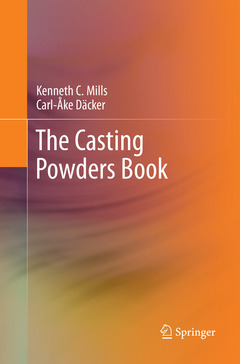Description
The Casting Powders Book, Softcover reprint of the original 1st ed. 2017
Authors: Mills Kenneth C., Däcker Carl-Åke
Language: English
Subjects for The Casting Powders Book:
137.14 €
In Print (Delivery period: 15 days).
Add to cartPublication date: 12-2018
Support: Print on demand
189.89 €
In Print (Delivery period: 15 days).
Add to cartPublication date: 10-2018
535 p. · 15.5x23.5 cm · Hardback
Description
/li>Contents
/li>Biography
/li>Comment
/li>
This book deals with casting powders and explains how they work and how they are best used to minimise defects in the ninety per cent of world steel production that is continuously cast. It also includes a chapter on mould powders for ingot-casting. The factors affecting various aspects of powder performance are described and different defects, their causes, and means of avoiding them are considered.
Providing the first comprehensive coverage of mould powder properties and uses, the text treats theoretical and practical matters and gives direct advice on problem-solving. Drawing on a wealth of scientific and technological research, represented by its extensive references, The Casting Powders Book shows readers how they can design and create mould powders optimised to fulfil the necessary functions of:
- lubrication of steel shells and reduction of shell?mould friction;
- absorption of inclusions floating up from the steel;
- chemical insulation of steel from carbon-rich mould powder; and
- protection of the steel meniscus from oxidation and thermal insulation to prevent surface-freezing.
Thermophysical properties and heat-transfer processes are also given detailed attention and case studies illustrate the methods and materials described.
The Casting Powders Book is designed to be a periodic reference that can be dipped into as the need arises. Readers from different backgrounds are well-served by the depth and variety of content:
- engineers trouble-shooting a continuous-casting process interested in how mould fluxes can minimise defects and process problems and how their performance is in turn affected by casting parameters;
- academic scientists interested in the theoretical aspects and properties of mould fluxes and slag films;
- engineers working with ingot-casting processes;and many others will find this book an invaluable resource.
1. Introduction and Overview.- 2. Slag Infiltration, Lubrication and Frictional Forces.- 3. Heat Transfer in the Mould and Shell Solidification.- 4. How to Manipulate Slag Behaviour in the Mould.- 5. Effect of Casting Variables on Mould Flux Performance.- 6. Different Types of Mould Powders.- 7. Fluxes for Ingot Casting.- 8. Manufacture of Mould Fluxes.- 9. Properties of Mould Fluxes and Slag Films.- 10. Selection of Mould Fluxes and Special Mould Fluxes for Continuous Casting.- 11. Using Mould Fluxes to Minimise Defects and Process Problems.
Carl-Åke Däcker, now working as Senior Scientific Advisor previously being Manager of the Materials& Process Development Department at Swerea KIMAB. In his work at the Institute he has dedicated most of his own research on mould powder development in close co-operation with the Swedish steelmakers and published around 10 conference papers in this field. In 2012 he was awarded Professor Hasse Fredriksson aw
These books may interest you

Tundish Technology for Clean Steel 152.55 €


